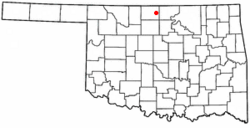Deer Creek, Oklahoma facts for kids
Quick facts for kids
Deer Creek, Oklahoma
|
|
|---|---|

Location of Deer Creek, Oklahoma
|
|
| Country | United States |
| State | Oklahoma |
| County | Grant |
| Area | |
| • Total | 0.14 sq mi (0.37 km2) |
| • Land | 0.14 sq mi (0.37 km2) |
| • Water | 0.00 sq mi (0.00 km2) |
| Elevation | 1,089 ft (332 m) |
| Population
(2020)
|
|
| • Total | 78 |
| • Density | 549.30/sq mi (211.35/km2) |
| Time zone | UTC-6 (Central (CST)) |
| • Summer (DST) | UTC-5 (CDT) |
| ZIP code |
74636
|
| Area code(s) | 580 |
| FIPS code | 40-19650 |
| GNIS feature ID | 2412414 |
Deer Creek is a small town in Grant County, Oklahoma, in the United States. It is named after a nearby stream. This stream flows into the Salt Fork of the Arkansas River.
In 2010, about 130 people lived in Deer Creek. This was a small decrease from the 147 people who lived there in 2000. By 2020, the population was 78.
Contents
The History of Deer Creek
Deer Creek started as a community on March 14, 1898. A man named W. A. Bradford bought land to build a town. He was the president of the Gulf Railroad. He wanted to create a town along the new railroad line. This line connected Medford and Blackwell, Oklahoma. The railroad was built between 1897 and 1898.
On February 27, 1899, the post office from a nearby community called Orie moved to Deer Creek. This helped the new town grow.
Early Churches in Deer Creek
The Deer Creek Mennonites formed their group on August 27, 1899. They opened their church building in 1902. Other church groups also started meeting. A Methodist minister led services in the home of Elijah Franklin Webster. By 1909, both Christian and Methodist church buildings were built.
Oil and Population Changes
In the early 1920s, people found oil and gas in the area. This caused a short period of growth for Deer Creek. The town's population reached its highest point in 1930, with 312 people.
After this time, the population slowly went down. By 1990, only 124 people lived there. Most businesses in the town had closed by 1998. Only one co-operative business remained. In the 21st century, the population has seen a small increase.
Where is Deer Creek Located?
Deer Creek is located about 12 miles (19 km) east of Medford. You can find it on Oklahoma State Highway 11. The stream that the town is named after, Deer Creek, is about one mile east of the community.
The United States Census Bureau says that the town covers an area of about 0.1 square miles (0.26 km2). All of this area is land.
Population of Deer Creek
| Historical population | |||
|---|---|---|---|
| Census | Pop. | %± | |
| 1910 | 166 | — | |
| 1920 | 218 | 31.3% | |
| 1930 | 312 | 43.1% | |
| 1940 | 250 | −19.9% | |
| 1950 | 209 | −16.4% | |
| 1960 | 215 | 2.9% | |
| 1970 | 203 | −5.6% | |
| 1980 | 174 | −14.3% | |
| 1990 | 124 | −28.7% | |
| 2000 | 147 | 18.5% | |
| 2010 | 130 | −11.6% | |
| 2020 | 78 | −40.0% | |
| U.S. Decennial Census | |||
In 2000, there were 148 people living in Deer Creek. There were 57 households and 40 families. The town had about 1,059 people per square mile.
About 31% of the people were under 18 years old. About 19% were 65 years old or older. The average age in the town was 38 years.
What People Do in Deer Creek
The economy of Deer Creek mostly depends on nearby wheat farms. By 1998, most businesses in the town had closed. This is according to the Encyclopedia of Oklahoma History and Culture.
Nearly three out of four people who work in Deer Creek travel to other places for their jobs.
See also
 In Spanish: Deer Creek (Oklahoma) para niños
In Spanish: Deer Creek (Oklahoma) para niños

